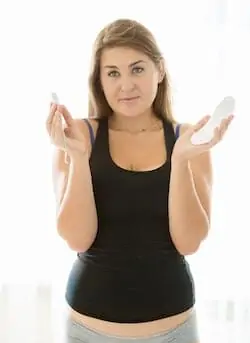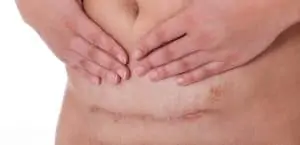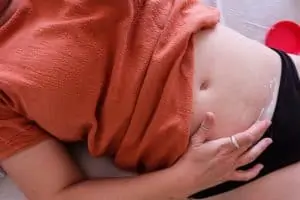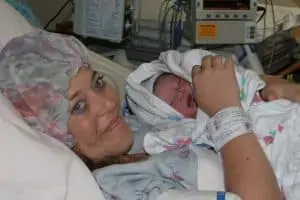No woman likes to wear a pad; it feels like you’re wearing an adult diaper. You might wonder about using tampons after a c-section instead of a pad when you have your baby. While it might sound appealing, tampons are not recommended directly after you have a c-section.
At first, it may seem like no big deal. You didn’t have a baby vaginally, so you don’t have any stitches, but you still can have soreness on your bottom, believe it or not.
Doctors do not recommend tampons; let me explain why you need to hold off a little longer.
Can I Use a Tampon After a C-Section?
The short answer is no – if you just had a c-section and are experiencing lochia, you cannot use a tampon. Doctors don’t recommend using a tampon until after you’ve had your six-week postpartum check-up.
Here’s why.

Even if you didn’t have a baby vaginally, you still have a large wound inside your uterus where the placenta is attached to your womb walls. When the placenta detached, it left a big, open wound, which is why you bleed and will continue to suffer for weeks to come.
Using tampons or menstrual cups before your lochia stops, a vital indicator that your wound has healed increases the risk of introducing bacteria into your vagina. That bacteria can easily find its way into your uterus, causing you to develop a uterine infection.
Lochia typically lasts anywhere from two to six weeks. C-section mothers often note that their bleeding is shorter, but it’s not abnormal to bleed for six weeks. No matter how you give birth, women still generally bleed for the same time.
What Can I Use for Lochia?
Directly after you have your baby, you need something that catches all of the blood. The hospital gives you pads that resemble a diaper, so what do you wear at home?
You do have to wear sanitary napkins for the first few weeks. I suggest that you grab one or two packs of maxi-pads, and then several containers of regular pads.
Lochia starts heavy during the first few days following your surgery. As the days and weeks progress, the bleeding gradually gets lighter and lighter.
How Soon Can You Wear a Tampon after a C-Section?
You can use a tampon as soon as your first postpartum menstrual cycle returns. Whether or not you’re breastfeeding, your period could return as early as eight weeks postpartum or after a year. Every woman’s body is different.
You might not expect that some women find it uncomfortable or even painful to use a tampon after a c-section. It’s unexpected because your vagina had no significant trauma or stitches after your c-section.
Despite not having a vaginal birth, you’ll still experience bleeding for weeks as your uterine wound heals and shrinks back to its normal size. The timeline for your uterus to heal, return to normal size, and your cervix to close is still the same no matter if you have a cesarean section or vaginal birth.
It’s not abnormal for your vagina to feel sore, and using a tampon can be uncomfortable for some time. Many women feel as if sex afterward is painful as well. Over time, this will lessen, but if your body doesn’t feel ready for a tampon, stick to menstrual pads for a longer time.
A few other suggestions include:
- Try rotating tampons and pads to give your vagina a “break” from a tampon feeling.
- Use a smaller size, even if it means that it won’t last as long.
- Try a different brand. You might be sensitive to the materials or chemicals used.
- When having sexual intercourse, spend time on foreplay and plenty of lubricants to make it more comfortable.
It’s For Your Safety
Not using tampons after a c-section may seem inconvenient, but the recommendation is truly for your safety. You’re healing from major surgery and adjusting to life with a new baby. The last thing you need or want to deal with is an infection brought on by using tampons too quickly after a cesarean section. Stay on the side of caution and avoid tampons for six weeks after your surgery.
Hey, this is Linda. My biggest accomplishment in life is being a mother of four children. Their current ages range from almost ten years old down to 20 months old.
I’m passionate about writing parenting articles because I understand so well all of the problems and trials you face as a parent. From breastfeeding woes to budgeting problems and behavior problems, along with everything in between, chances are I’ve faced it over the last ten years. Read more about Linda here.






